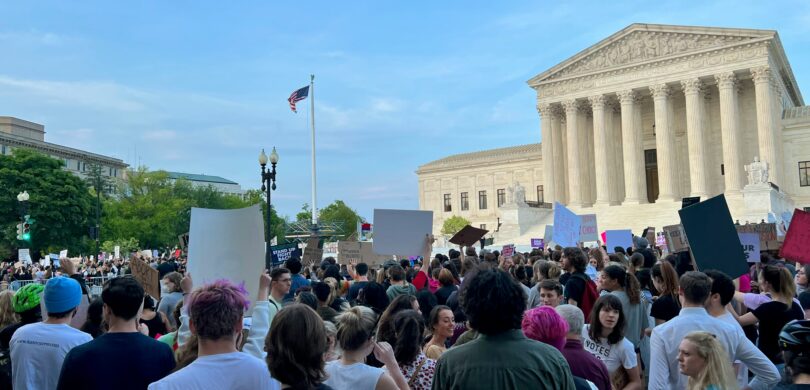Now that Roe v. Wade has been overturned, abortion may impact United States elections more than it has in a long time.
Federal protections on abortion rights no longer apply since June 2022, when the U.S. Supreme Court overruled the landmark case that set them. Many states have passed outright bans or heavy restrictions on abortion. Nationwide, though, public support for abortion rights is higher than ever, and the Court’s decision will likely bring voters to the polls. Read on to learn more about abortion and the 2024 elections.
History of Abortion Rights in the US
America had virtually no abortion laws early in the country’s history. In the late 1800s, state governments began to pass laws that restricted abortion. Abortion was largely practiced by midwives and opposed by physicians, whose profession was becoming licensed and regulated. The practice was outlawed in every state by the early 1900s. Some women turned to costly or risky methods of ending their pregnancies. They paid a surgeon to perform an abortion secretly or, if they could not afford it, tried to perform it themselves.
As women challenged these abortion bans in the 1960s and 70s, states began to allow exceptions for health, rape, incest, or a damaged fetus.
Key Supreme Court Cases
In the 1973, the Supreme Court ruled in Roe v. Wade that the right to an abortion is protected by the U.S. Constitution as part of an implied right to privacy. It prohibited most restrictions during the first trimester of pregnancy, allowed some in the second trimester, and allowed abortion bans in the third trimester with exceptions for the mother’s life or health.
Roe v. Wade ignited nationwide controversy, and abortion is now a polarized and contentious issue. The Democratic Party had opposed abortion, but it soon joined feminists in advocating for abortion rights. Protestants joined Catholics in the anti-abortion movement as the political Christian right emerged, eventually gaining the support of the Republican Party.
The Supreme Court changed Roe’s legal framework in 1992 with its ruling in Planned Parenthood v. Casey. States could now ban abortion at 23 or 24 weeks of pregnancy based on fetal viability. The Court also ruled that laws could not pose an “undue burden” on women’s access to abortion, replacing the more demanding “strict scrutiny” standard from Roe.
In June of 2022, the Supreme Court overturned the Roe and Casey decisions with its ruling in Dobbs v. Jackson Women’s Health Organization. The Court ruled that there is no implied constitutional right to abortion, because it is not “deeply rooted in this nation’s history or tradition.” This allowed state governments to greatly restrict and ban abortion.
The Current Landscape of Abortion Access
In the years leading up to the Dobbs decision, several states passed “trigger laws” – abortion laws that were unenforceable due to Roe but went into effect when it was overturned. Since the Supreme Court ruling, more states have passed restrictions, while others have enacted protections.
Abortion is now banned in 14 states, with most having narrow exceptions. Four states ban abortions after six weeks of pregnancy – before many women even realize they are pregnant. Another 23 states have other restrictions based on gestational age, while nine states allow abortion throughout pregnancy.
Abortions have drastically reduced in states that have banned them and risen in states that have expanded or maintaned access. More people are now traveling out of state to end pregnancies, but some cannot afford to do so. This disproportionately impacts women of color and women in poverty.
However, the Dobbs decision has not lowered the nationwide abortion rate. It was already growing in previous years, and some estimates indicate that it is still on the rise.
Recent State Actions
State action on abortion rights varies and often falls along partisan lines. In general, Democratic-controlled legislatures are aiming to expand or maintain access to abortion. Republican states, on the other hand, have taken steps to heavily restrict reproductive rights. Overall, however, the vast majority of Americans support at least some access to abortion.
In November 2023, Ohio voters approved a ballot measure for a constitutional amendment to protect the right to “make and carry out one’s own reproductive decisions,” including decisions about abortion. This invalidated a six-week ban the state legislature had passed as a trigger law in 2019.
Abortion laws in Florida (SB 300) and Iowa (HF 732) both took effect in 2024, banning abortions after six weeks of pregnancy. They were passed last year but temporarily blocked by court challenges.
Abortion on the Ballot
Abortion will appear on the ballot in several states in 2024, and it could play a major role in both state and federal elections. The two major party candidates differ greatly in their views on abortion.
Vice President Harris is the likely Democratic nominee after President Biden dropped out of the race in July. Harris and Biden both support abortion rights, but Harris is more outspoken about the issue and will likely more aggressively campaign on it. As a senator, she co-sponsored the Women’s Health Protection Act of 2017, which sought to ban state and local restrictions on abortion before fetal viability.
Former President Trump, a Republican, has said he prefers to allow states to decide on the issue of abortion, stopping short of calling for a national abortion ban. During his 2016 campaign, he promised to appoint judges who were likely to overturn Roe. Trump did name three justices to the Supreme Court to fill vacancies during his term, shifting the nine-member court toward a more conservative ideology. All three voted in favor of the Dobbs decision. Trump touts his Supreme Courts appointments as an administration-defining success.
Supreme Court justices, court of appeals judges, and district court judges are appointed by the President and confirmed by the Senate. Dobbs highlighted the impact that elections for these offices can have on abortion law.
State Ballot Measures in 2024
As of July, seven states will let voters decide directly on abortion ballot initiatives in the 2024 election. These include both laws and amendments to state constitutions, all protecting or expanding abortion access. Most were initiated by voter petitions.
- Arizonans will vote on a constitutional amendment protecting the right to abortion until viability. The state now bans abortion after 15 weeks of pregnancy.
- Florida ballots will include a measure to legalize abortion until viability. The state currently bans it after six weeks of pregnancy.
- In South Dakota, voters will decide on a constitutional amendment setting a trimester framework for abortion laws similar to Roe v. Wade. Abortion is currently banned in the state.
- New Yorkers will have a ballot measure to ban discrimination based on pregnancy, pregnancy outcomes, and “reproductive healthcare and autonomy.” The state allows abortion until viability.
- Colorado, Maryland, and Nevada will vote on constitutional amendments to protect abortion access until viability, which their state laws already allow.
Four more states are waiting for approval of their ballot initiatives.
- Arkansas voters could decide on a constitutional amendment protecting the right to abortion in the first 20 weeks of pregnancy. Abortion is banned in the state.
- Missouri, Nebraska, and Montana may vote on constitutional amendments protecting the right to abortion before viability. Abortion is illegal throughout pregnancy in Missouri and until 12 weeks in Nebraska. It is already legal until viability in Montana.
These measures could turn out more abortion-minded voters to the polls, affecting results in other contests on the ballot.
Abortion and the 2024 Elections
Before the Dobbs decision, voters who were motivated primarily by abortion tended to be Republicans who opposed it. But recent polls show that abortion-motivated voters are now mostly Democrats who support abortion rights.
Abortion is a top issue for suburban women, a key demographic that could decide the election. The overturning of Roe seems to have mobilized pro-choice voters, while pro-life voters may be less energized by the issue.
Sixty-nine percent of Americans, a record high, now say that abortion should be legal in the first three months of pregnancy. This view is at odds with the total and six-week abortion bans passed by many Republican-controlled state legislatures. Sixty one percent of Americans also say that overturning Roe v. Wade was a “bad thing.” Views are strongly divided by party affiliation, but overall support for abortion access continues to rise.
The Republican Party is starting to downplay the issue, making few mentions of it at this year’s Republican National Convention. Meanwhile, the Democratic Party is stressing it as a key issue. Democrats scored wins with that strategy in the 2022 midterm elections. Abortion was a top concern for voters in Pennsylvania and Michigan, both battleground states. Voters in Pennsylvania went on to flip a U.S. Senate seat for the Democrats, and control of Michigan’s state legislature also swung to the Democrats for the first time in decades. Nationwide, every ballot initiative on abortion went in favor of protecting or expanding access.
Looking at abortion and 2024 elections, this issue could greatly influence races up and down the ballot.
Get Started with Plural
Plural offers policy tracking solutions for concerned constituents and professional public policy teams alike.
Create a Free Account
- Legislative searching and tracking for one person.
- Search legislative data from 53 US jurisdictions: 50 states, Washington, D.C., Puerto Rico, and U.S. Congress.
- See comprehensive bill details, state-specific data, and legislator information.
- Easily track bills and never miss an update.
- Receive daily updates on the bills you’re monitoring.
Book a Demo To Learn About Premium Features
- Access superior public policy data
- Be the first to know about new bills and changes in bill status
- Streamline your day with seamless organization features
- Harness the power of time-saving AI tools to gain insights into individual bills and the entire legislative landscape
- Keep everyone on the same page with internal collaboration and external reporting all in one place




